Each year, approximately 500,000 patients, including those with rheumatoid arthritis and osteoarthritis, undergo total hip, knee and other joint replacement surgery in the United States. The clinical performance of implanted devices can be followed and studied. In addition, a fraction of these implants are removed each year for reasons such as infection, osteolysis, or mechanical failure of the components. The removed or revised components can be preserved for analysis. They provide a rich resource with which to examine the influence of surgical, patient, design, and material factors on the long-term performance of these devices.
The overall objective of the Center for the Evaluation of Implant Performance is to correlate evidence of the mechanical behavior of implanted and retrieved devices - including allograft tissue - with clinical, material, design, and manufacturing variables.
Recent Publication Highlights
Crocker DB, Hoffman I, Carter JLW, Akkus O, Rimnac CM. Fatigue crack propagation and fracture toughness of cortical bone are radiation dose-dependent. J Orthop Res. 2022 Aug 10. doi: 10.1002/jor.25424. Epub ahead of print. PMID: 35949192.
Cortical bone allograft sterilized with a standard γ-radiation dose of 25-35kGy has demonstrated reduced static and cyclic fracture resistance compared with unirradiated bone. To mitigate radiation damage, we recently observed a dose-dependent response of high-cycle fatigue behavior of human cortical bone from 0 to 25 kGy, with lower doses exhibiting logarithmically longer fatigue lives. The objectives of this study were as follows: (1) to determine whether fracture toughness, work-to-fracture, and fatigue crack propagation resistance of human cortical
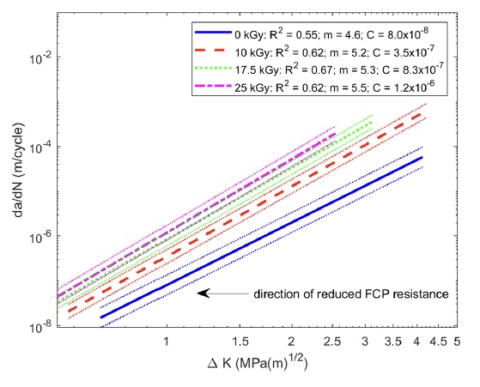
bone are also radiation dose-dependent, and (2) to determine the associations of radiation dose and a Raman biomarker for collagen disorder with fracture properties. Compact tension specimens were machined from two donor femoral pairs and allocated to four treatment groups: 0 (unirradiated control), 10, 17.5, and 25 kGy. Fracture toughness specimens were monotonically loaded to failure and the critical stress intensity factor (KC ) was determined. Work-to-fracture was calculated from the load versus displacement integral up to fracture. Fatigue crack propagation specimens were cyclically loaded under constant room-temperature irrigation and fatigue crack growth rate (da/dN) and cyclic stress intensity (∆K) were calculated. Fracture toughness, work-to-fracture, and fatigue crack propagation resistance decreased 18%, 33%, and 15-fold from 0 to 25 kGy, respectively (p < 0.05). Radiation dose was more predictive of fracture properties than collagen disorder. These findings support that quasi-static and fatigue fracture properties of cortical bone are radiation dose-dependent within this dose range. The structural alterations arising from irradiation that cause these losses in fracture resistance remain to be elucidated.
Bigach SD, Kolevar MP, Moore RD, Adavi P, Rimnac CM, Kraay MJ. Dual-Energy X-Ray Absorptiometry (DEXA) Evaluation of the Bone Remodeling Effects of a Low-Modulus Composite Hip Stem After 2 Decades of Follow-Up. HSS Journal®. 2022;0(0). doi:10.1177/15563316221108182
Background: The Epoch FullCoat Hip Stem (Zimmer) was an isoelastic composite femoral stem developed to address stem stiffness concerns. Purpose: We sought to evaluate the long-term bone mineral density (BMD) of a cohort of patients who underwent total hip arthroplasty (THA) using the Epoch isoelastic stem and having more than 2-decade follow-up.
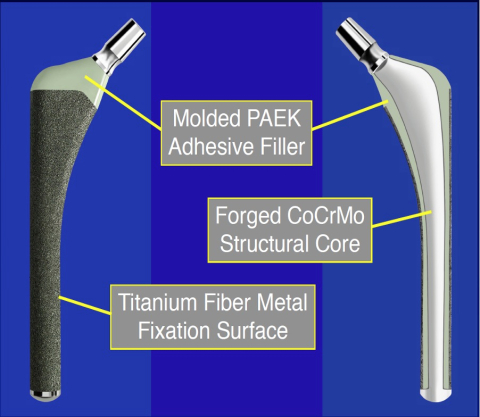
Methods: We conducted a retrospective chart review of all patients who were study subjects at our institution in a multicenter prospective trial for the Food and Drug Administration of the Epoch implant in the mid-1990s. Through this, we identified 16 patients who had dual-energy X-ray absorptiometry (DEXA) scans, with which we could determine BMD preoperatively and at 3 points postoperatively. Of these, 5 agreed to participate in the study (the others were deceased, unable or declined to participate, or were lost to follow-up) with mean follow-up of 22 years. These participants underwent clinical and radiographic evaluation consisting of a Harris hip score, anteroposterior (AP) pelvis and AP and lateral hip X-rays, and DEXA evaluation of both hips. BMD in the 7 Gruen zones at last follow-up was compared with immediate postoperative and 2-year follow-up. Results: At last follow-up, all stems were well-fixed with signs of extensive osteointegration. In proximal Gruen zones 1 and 7, patients underwent a decrease in BMD with more modest losses in Gruen zone 1. All patients demonstrated an increase in BMD in zones 2 through 6 at latest follow-up, except for 1 patient in Gruen zone 6. BMD changes were not limited to the first 2 years of follow-up. Conclusion: This small follow-up cohort study found excellent long-term clinical results, no plain radiographic signs of notable stress shielding, and general maintenance of BMD at a follow-up of over 20 years for this isoelastic stem. Long-term bone remodeling after implantation of the isoelastic stem resulted in increased BMD in Gruen zones 2 through 6, suggesting that composite implant designs may still have a role in THA.
Ina J, Vakharia A, Akkus O, Rimnac CM. The High-cycle Fatigue Life of Cortical Bone Allografts Is Radiation Sterilization Dose-dependent: An In Vitro Study. Clin Orthop Relat Res. 2022 Jun 1;480(6):1208-1219. doi: 10.1097/CORR.0000000000002146. Epub 2022 Feb 17. PMID: 35175232; PMCID: PMC9263473.
Background: Structural cortical bone allografts are a reasonable treatment option for patients with large cortical bone defects caused by trauma, tumors, or complications of arthroplasty. Although structural cortical bone allografts provide the benefit of an osteoconductive material, they are susceptible to fatigue failure (fracture) and carry a risk of disease transmission. Radiation-sterilization at the recommended dose of 25 kGy decreases the risk of disease transmission. However, previous studies demonstrated that radiation sterilization at this dose can negatively impact the high cycle-fatigue life of cortical bone. Although the effects of higher doses of radiation on cortical bone allografts are well described, the effects of lower doses of radiation on a high-cycle fatigue life of cortical bone are poorly understood.
Questions/purposes: (1) Does the cycle-fatigue life of human cortical allograft bone vary with gamma radiation dose levels of 0 (control), 10 kGy, 17.5 kGy, and 25 kGy? (2) What differences in Raman spectral biomarkers are observed following varying doses of gamma radiation exposure?
Methods: The high-cycle fatigue behavior of human cortical bone specimens was examined at different radiation sterilization doses under physiologic stress levels (35 MPa) and in a 37° C phosphate-buffered saline bath using a custom-designed rotating-bending fatigue device. Six human femora from three donors were obtained for this study (two male, 63 and 61 years old, respectively, and one female, 48 years old). Test specimens were allocated among four treatment groups (0 kGy [control], 10 kGy, 17.5 kGy, and 25 kGy) based on donor and anatomic location of harvest site (both length and cross-sectional quadrant of femoral diaphysis) to ensure equal variation (n = 13 per group). Specimens underwent high-cycle fatigue testing to failure. The number of cycles to failure was recorded. Raman spectroscopy (a noninvasive vibrational spectroscopy used to qualitatively assess bone quality) was used to detect whether any changes in Raman spectral biomarkers occurred after varying doses of gamma radiation exposure.
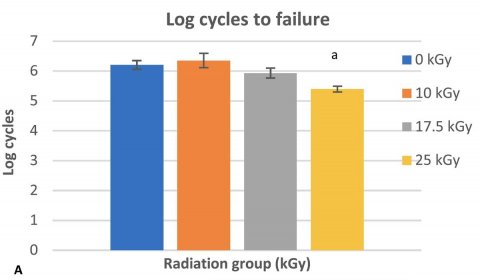
Results: There was a decrease in the log-transformed mean high-cycle fatigue life in specimens irradiated at 25 kGy (5.39 ± 0.32) compared with all other groups (0 kGy: 6.20 ± 0.50; 10k Gy: 6.35 ± 0.79; 17.5 kGy: 6.01 ± 0.53; p = 0.001). Specimens irradiated at 25 kGy were also more likely to exhibit a more brittle fracture surface pattern than specimens with more ductile fracture surface patterns irradiated at 0 kGy, 10 kGy, and 17.5 kGy (p = 0.04). The Raman biomarkerfor the ratio of the relative amount of disordered collagen to ordered collagen showed a decrease at the 10 kGy radiation level from 1.522 ± 0.025 preirradiation to 1.489 ± 0.024 postirradiation (p = 0.01); no other detectable changes in Raman biomarkers were observed.
Conclusion: The high-cycle fatigue life of cortical bone undergoes a nonlinear, dose-dependent decrease with an increase in gamma radiation sterilization in a clinically relevant dose range (0-25 kGy). Importantly, a notable drop-off in the high-cycle fatigue life of cortical bone appeared to occur between 17.5 kGy and 25 kGy, correlating to a sixfold decrease in mean cycles to failure. We speculate that the decrease in the Raman biomarker for disordered collagen at 10 kGy with no loss in high-cycle fatigue life may be caused by an increased amount of nonenzymatic crosslinking of the collagen backbone relative to collagen chain-scission (whereas the benefits of crosslinking may be outweighed by excess scission of the collagen backbone at higher radiation doses), but future studies will need to ascertain whether this in fact is the case.
Clinical relevance: Radiation sterilization at the industry standard of 25 kGy has a substantial negative impact on the high-cycle fatigue life of cortical bone. Given these findings, it is possible to provide a meaningful increase in the high-cycle fatigue life and improve the overall functional lifetime of cortical bone allografts by lowering the radiation-sterilization dose below 25 kGy. Future work on radiation-sterilization methods at these clinically relevant doses is warranted to aid in preserving the high cycle fatigue life of cortical bone allografts while maintaining sterility.
Yakkanti RR, Ocksrider JL, Patel AA, Kolevar MP, Moore RD, Rimnac CM, Kraay MJ, Wright TM, Baral EC, Robinson RP. Unexpected Wear of a Uniquely Designed Moderately Cross-Linked Polyethylene in Total Hip Arthroplasty. J Arthroplasty. 2022 Jun;37(6):1130-1135. doi: 10.1016/j.arth.2022.01.093. Epub 2022 Feb 5. PMID: 35131388.
Background: A uniquely designed, non-heat-treated moderately cross-linked acetabular polyethylene liner used in total hip arthroplasty (THA) demonstrated excessive wear during routine follow-up, prompting an evaluation of the linear wear rate.
Methods: All THAs were performed by the senior author. The study group included 38 THAs using the uniquely designed polyethylene in question, compared to a control group of 21 THAs using another moderately cross-linked polyethylene with good 10-year outcomes. Two-dimensional linear head penetration wear measurements were obtained using the Martell Hip Analysis Suite, and retrieval analysis was performed on two liners.
Results: The study group had a significantly higher average penetration rate of 0.089 mm/y than the control group average rate of 0.047 mm/y (P = .04). Forty-five percent of the study group had a wear rate above the osteolysis threshold (0.1 mm/y), compared to 24% in the control group. Macroscopic analysis of two retrieved liners validated the radiographic findings.
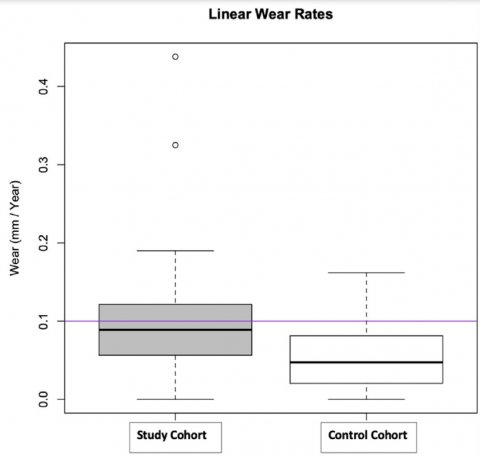
Conclusion: The data suggest unexpectedly higher wear rates for a moderately cross-linked polyethylene design, with nearly half of the study group at risk for osteolysis. Further registry or database analyses of this particular moderately cross-linked polyethylene are warranted.
Du, Jerry, Flanagan, Christopher, Bensusan, Jay, Knusel, Konrad, Akkus, Ozan, Rimnac, Clare. Raman Biomarkers Are Associated with Cyclic Fatigue Life of Human Allograft Cortical Bone. J Bone Joint Surg Am. 2019;101(17):e85.
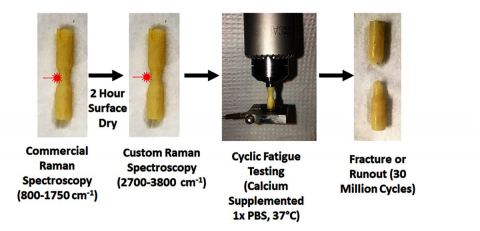
Background: Structural bone allografts are an established treatment method for long-bone structural defects resulting from such conditions as traumatic injury and sarcoma. The functional lifetime of structural allografts depends on resistance to cyclic loading (cyclic fatigue life), which can lead to fracture at stress levels well below the yield strength. Raman spectroscopy biomarkers can be used to non-destructively assess the 3 primary components of bone (collagen, mineral, and water), and may aid in optimizing allograft selection to decrease fatigue fracture risk. We studied the association of Raman biomarkers with the cyclic fatigue life of human allograft cortical bone.
Methods: Twenty-one cortical bone specimens were machined from the femoral diaphyses of 4 human donors (a 63-year old man, a 61-year-old man, a 51-year-old woman, and a 48-year-old woman) obtained from the Musculoskeletal Transplant Foundation. Six Raman biomarkers were analyzed: collagen disorganization, mineral maturation, matrix mineralization, and 3 water compartments. The specimens underwent cyclic fatigue testing under fully reversed conditions (35 and 45 MPa), during which they were tested to fracture or to 30 million cycles (“runout”), simulating 15 years of moderate activity. A tobit censored linear regression model for cyclic fatigue life was created.
Results: The multivariate model explained 60% of the variance in the cyclic fatigue life (R2=0.604,p<0.001). Increases in Raman biomarkers for disordered collagen (coefficient: 22.74·107, p < 0.001) and for loosely collagen-bound water compartments (coefficient: 22.11·108, p < 0.001) were associated with a decreased cyclic fatigue life. Increases in Raman biomarkers for mineral maturation (coefficient: 3.50·108, p < 0.001), matrix mineralization (coefficient: 2.32·106, p < 0.001), tightly collagen-bound water (coefficient: 1.19·108, p < 0.001), and mineral-bound water (coefficient: 3.27·107, p < 0.001) were associated with an increased cyclic fatigue life. Collagen disorder accounted for 44% of the variance in the cyclic fatigue life, mineral maturation accounted for 6%, and all bound water compartments accounted for 3%.
Conclusions: Increasing baseline collagen disorder was associated with a decreased cyclic fatigue life and had the strongest correlation with the cyclic fatigue life of human cortical donor bone. This model should be prospectively validated.
Clinical Relevance: Raman analysis is a promising tool for the non-destructive evaluation of structural bone allograftquality for load-bearing applications.
